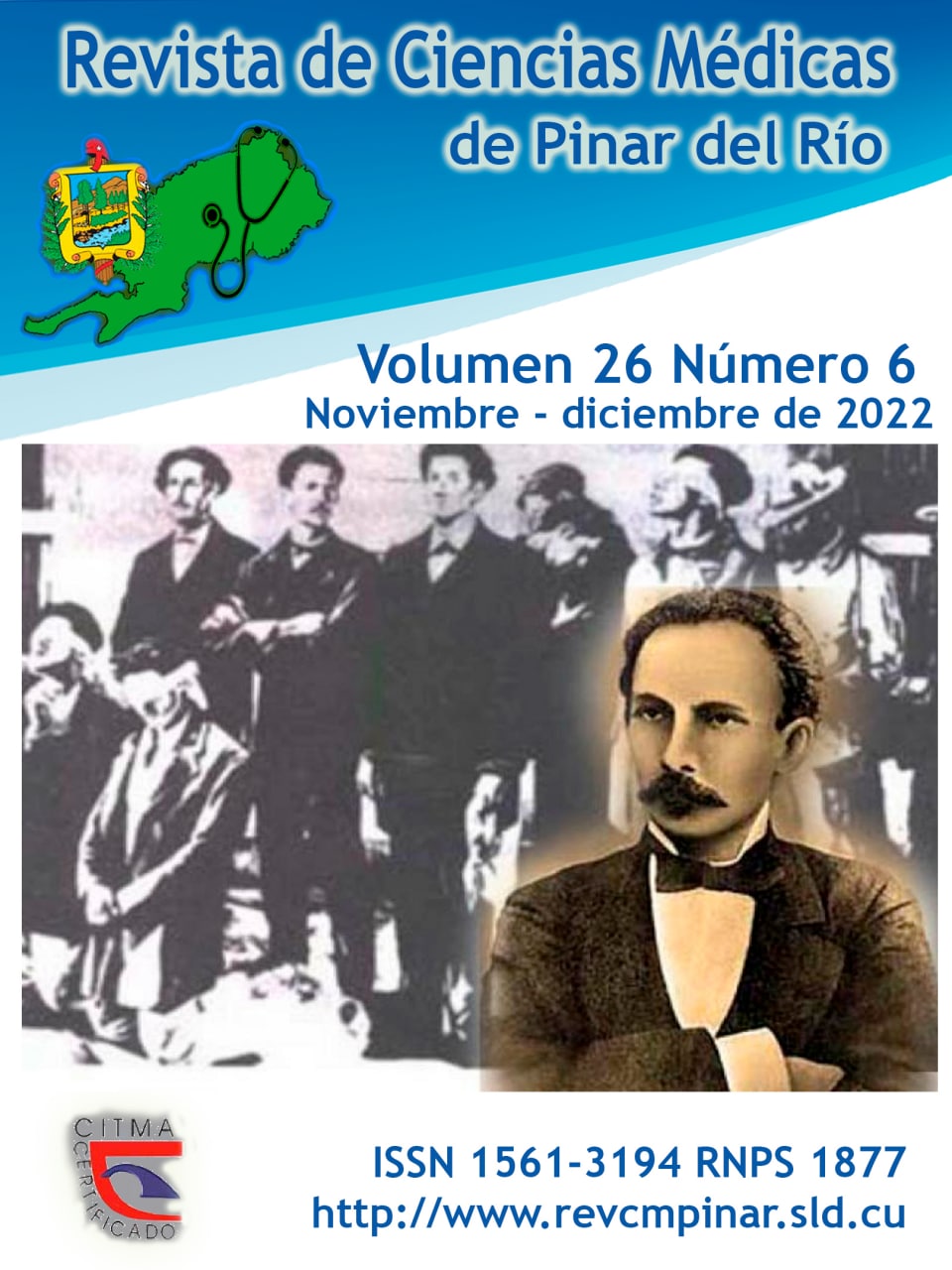Clinical-epidemiological behavior of patients with a diagnosis of bipolar affective disorder
Keywords:
COFFEE, EPIDEMIOLOGY, BIPOLAR DISORDER, MENTAL DISORDERS.Abstract
Introduction: the first cases of bipolar episodes were described in the 2nd century after the common era by Arateus of Cappadocia, later Kraepelin, reports manic-depressive psychoses between 1904 and 19212.
Objective: to characterize patients diagnosed with bipolar affective disorder.
Methods: an observational, descriptive and transversal study was carried out at the Provincial Psychiatric Hospital "Luis Ramírez López" of Guantánamo municipality, Guantánamo province, in the year 2021. The universe was constituted by 41 patients diagnosed with bipolar affective disorder. The following variables were studied: age, sex, origin, race, type of episode at admission, schooling, marital status and toxic habits. Descriptive indicators were obtained through the SPSS 23,0; statistical package, as well as totals and percentages.
Result: the predominance of the age group over 60 years old was observed, which represents 30 %, followed by the group from 31 to 40 years old for 25 %. It can be seen that the type of schooling that prevailed was the pre-university level with 47,5 % and the marital status at hospital admission was that of single patients with 65 %. Within the toxic habits it can be appreciated the high incidence of patients under coffee consumption with 37,5 %.
Conclusions: bipolar affective disorder occurred mainly in women, older than 60 years of age, with high schooling and single marital status, with episode at admission of manic and history of coffee consumption.
Downloads
References
1. Pascual Sánchez A. Calidad de vida, distrés y autoestigma en pacientes con trastorno bipolar en eutimia [Tesis]. Reino Unido: Universidad de Salamanca; 2020. Disponible en: https://gredos.usal.es/handle/10366/144177
2. Ramírez Vargas X, Arias Leal ML, Madrigal Zamora S. Actualización del trastorno afectivo bipolar. Rev Méd. Sinergia[Internet]. 2020 [citado 13/05/2022]; 5(9): e572. Disponible en: https://doi.org/10.31434/rms.v5i9.572
3. Valdivieso-Jiménez G. Severidad Clínica En Trastorno Bipolar, Trastorno Límite De La Personalidad Y Su Comorbilidad. Rev. chil. neuro-psiquiatr [Internet]. 2020 [citado 07/05/2022]; 58(1): 2-15. Disponible en: http://www.scielo.cl/scielo.php?script=sci_arttext&pid=S0717-92272020000100002&lng=es
4. Fernández Gutiérrez M. BIPOLAR DISORDER IN COMMUNITY CARE A perspective from the nurse's role. [Tesis]. España: Universidad de Cantabria; 2020. Disponible en: https://repositorio.unican.es/xmlui/handle/10902/19930
5. García-Blanco AC, Sierra P, Livianos L. Nosología, epidemiología y etiopatogenia del trastorno bipolar: Últimas aproximaciones. Rev Psiquiatría Biológica [Internet]. 2014 [citado 14/05/2022]; 21(3): 89–94. Disponible en: http://dx.doi.org/10.1016/j.psiq.2014.07.004
6. Martínez-Hernández O, Montalván-Martínez O, Betancourt-Izquierdo Y. Trastorno Bipolar. Consideraciones clínicas y epidemiológicas. Revista Médica Electrónica [Internet]. 2019 [citado 14/05/2022]; 41(2): 467-482. Disponible en: http://www.revmedicaelectronica.sld.cu/index.php/rme/article/view/
7. Méndez CJI, Lara TH. Características clínicas y epidemiológicas del Trastorno Bipolar en el Instituto Nacional de Neurología y Neurocirugía 'Manuel Velasco Suárez'. Rev Neurol Neurocir Psiquiat [Internet]. 2002 [citado 28/05/2022]; 35(3): 132-137. Disponible en: https://www.medigraphic.com/cgi-bin/new/resumen.cgi?IDARTICULO=71764
8. Ovejero García S. Estabilidad diagnóstica del trastorno bipolar en la comunidad de madrid [Tesis]. España: Universidad Autónoma de Madrid; 2019[citado 14/05/2022]. Disponible en: https://dialnet.unirioja.es/servlet/tesis?codigo=282951
9. Gago Velasco B. Influencia de los episodios afectivos bipolares en el procesamiento emocional: sesgos atencionales, respuesta a la frustración y juicios morales [Tesis]. España: Universidad de València; 2020 [citado 14/05/2022]. Disponible en: https://roderic.uv.es/handle/10550/76409
10. Latorre Cabero R. Evaluación e intervención neuropsicológica en un caso de trastorno bipolar I [Tesis]. España: Universidad Oberta de Catalunya; 2020 [citado 14/05/2022]. Disponible en: http://openaccess.uoc.edu/webapps/o2/handle/10609/113326
11. Yanchaliquín Yanchaliquín CD. Programa de intervención en personas diagnosticadas con trastorno bipolar en relación a su bienestar psicológico [Tesis]. Ecuador: Pontificia Universidad Católica del Ecuador; 2020 [citado 14/05/2022]. Disponible en: https://repositorio.pucesa.edu.ec/handle/123456789/
12. Cruzado L, Sánchez-Fernández M, Cortez-Vergara C, Rojas-Rojas G. Manía inducida por bebidas energéticas con alto contenido de cafeína. Actas Esp Psiquiatr [Internet]. 2014 [citado 14/05/2022]; 42(5): 259-62. Disponible en: https://dialnet.unirioja.es/servlet/articulo?codigo=4787542
Downloads
Published
How to Cite
Issue
Section
License
Authors who have publications with this journal agree to the following terms: Authors will retain their copyrights and grant the journal the right of first publication of their work, which will be publication of their work, which will be simultaneously subject to the Creative Commons Attribution License (CC-BY-NC 4.0) that allows third parties to share the work as long as its author and first publication in this journal are indicated.
Authors may adopt other non-exclusive license agreements for distribution of the published version of the work (e.g.: deposit it in an institutional telematic archive or publish it in a volume). Likewise, and according to the recommendations of the Medical Sciences Editorial (ECIMED), authors must declare in each article their contribution according to the CRediT taxonomy (contributor roles). This taxonomy includes 14 roles, which can be used to represent the tasks typically performed by contributors in scientific academic production. It should be consulted in monograph) whenever initial publication in this journal is indicated. Authors are allowed and encouraged to disseminate their work through the Internet (e.g., in institutional telematic archives or on their web page) before and during the submission process, which may produce interesting exchanges and increase citations of the published work. (See The effect of open access). https://casrai.org/credit/



